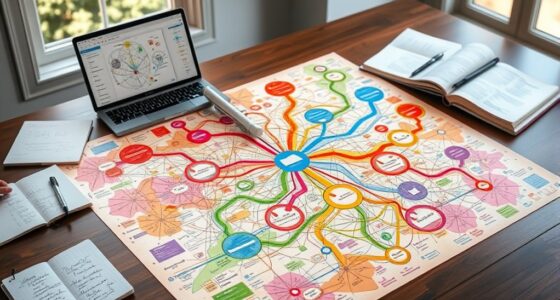To prioritize like a president using the Eisenhower Matrix, you need to categorize your tasks based on urgency and importance, focusing first on critical, long-term goals. By dedicating time to important but not urgent activities, delegating minor tasks, and eliminating trivial chores, you guarantee strategic decision-making. This method helps you stay proactive and balanced, avoiding crises and burnout. Continue exploring how to master this powerful tool to maximize productivity and achieve your objectives efficiently.
Key Takeaways
- Prioritize tasks based on urgency and importance to focus on impactful activities, similar to presidential decision-making.
- Use the four quadrants to distinguish between immediate crises and strategic long-term goals.
- Delegate or eliminate less critical tasks to free resources for high-priority, mission-critical actions.
- Regularly review and adjust priorities to stay aligned with overarching objectives and prevent distraction.
- Schedule dedicated time for important but non-urgent tasks to maintain strategic planning and sustainable growth.
Understanding the Core Concept of the Eisenhower Matrix
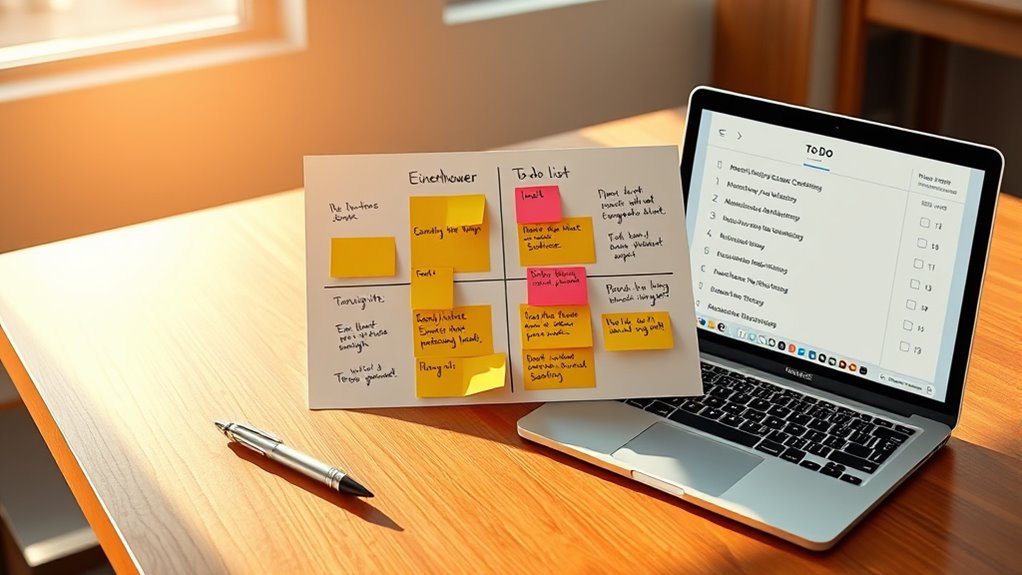
Have you ever wondered how to quickly decide what tasks deserve your attention first? The Eisenhower Matrix helps you do just that by dividing tasks into four quadrants based on their urgency and importance. Named after President Dwight D. Eisenhower, who valued productivity, this framework was popularized by Stephen Covey. Its core idea is simple: urgent tasks demand immediate action but aren’t always meaningful, while important tasks align with your long-term goals and values. By separating these, you prevent reacting solely to crises or distractions. The goal is to focus on what truly matters, reduce stress, and make smarter decisions. This method visually clarifies priorities, helping you allocate your time effectively and avoid wasting energy on trivial activities. Incorporating time management techniques like the Eisenhower Matrix can further enhance your productivity and focus. Understanding the utilitarian principles behind prioritization can also guide ethical decision-making in balancing individual and collective needs. Additionally, adopting a digital-friendly environment at home can support sustained focus and efficiency in managing tasks. Recognizing the importance of task categorization can also help streamline your workflow and ensure that critical responsibilities are addressed promptly. Moreover, integrating cultural intelligence strategies can improve collaboration in team settings, especially when managing diverse workloads and priorities.
The Four Quadrants: What They Reveal About Your Tasks
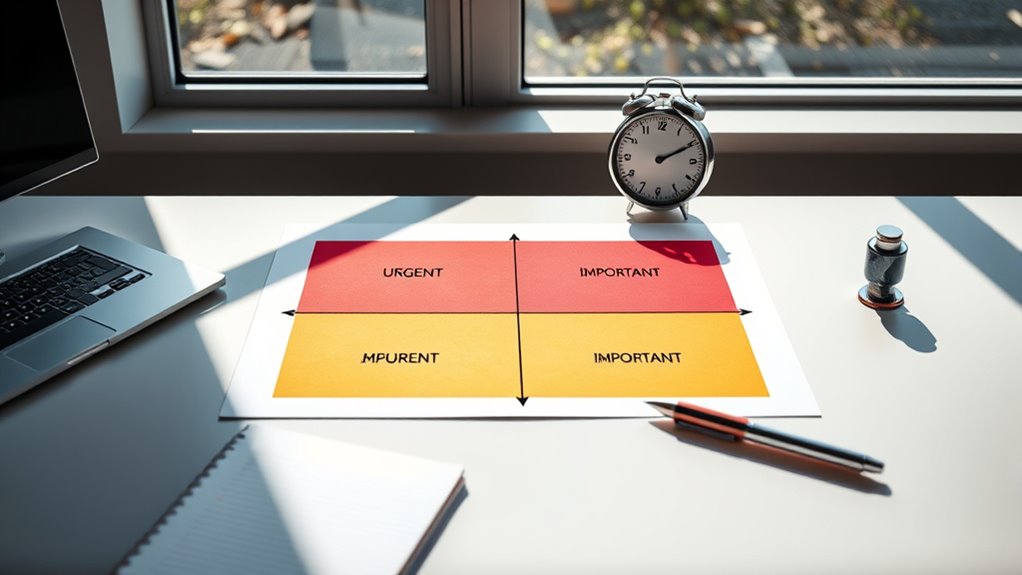
What do your daily tasks say about your priorities? Your tasks fall into four quadrants, revealing your focus. If most are urgent and important, you’re often firefighting, risking burnout. Tasks in this quadrant demand immediate action—crises, deadlines, emergencies—that can overshadow strategic planning. If you spend time on important but not urgent tasks, like skill-building and long-term projects, you’re investing in growth and prevention. Tasks that are urgent but not important, such as non-critical emails or minor interruptions, often distract you from meaningful work and should be delegated. Activities that are neither urgent nor important, like mindless scrolling or trivial chores, drain your productivity and should be eliminated. Recognizing where your tasks fall helps you understand your priorities and adjust to focus on what truly matters. Additionally, incorporating priority management tools like the Eisenhower Matrix can help you categorize tasks more effectively and improve your overall productivity, especially when combined with a holistic approach to task prioritization. Utilizing techniques such as task batching can further streamline your workflow and reduce unnecessary distractions. Being aware of exfoliation benefits, such as clearer and more radiant skin, can motivate you to incorporate effective skincare routines into your daily schedule. Moreover, understanding the impact of stress on your productivity can help you implement relaxation techniques that support better focus and well-being.
How to Effectively Categorize Your Daily Activities

To categorize your daily activities effectively, start by evaluating each task’s urgency and importance. Use clear criteria—like deadlines, consequences, and long-term impact—to determine where each task fits. Properly applying these assessment points ensures you prioritize what truly matters and manage your time efficiently. Incorporating techniques like the Eisenhower Matrix can help you prioritize effectively and focus on tasks that yield the most significant results. Additionally, understanding specific asset division laws can further refine your approach to managing complex tasks. Practicing smooth gear shifting techniques can also contribute to better planning and execution of physical tasks, fostering a more disciplined approach to prioritization. Being aware of expiration dates of items like vape juice or cranberry juice can prevent waste and ensure safety, emphasizing the importance of timely decision-making in daily routines.
Priority Assessment Criteria
Understanding how to categorize your daily activities effectively hinges on evaluating two key factors: urgency and importance. These criteria help you determine where to focus your energy. Incorporating principles from Maximize Space and Organization, you can also apply decluttering strategies to streamline tasks and reduce overwhelm. Recognizing the importance of a well-designed Bedroom can also influence how you prioritize your daily routines related to relaxation and self-care. For example, optimizing your Coffee Brewing Routine can improve your morning productivity and set a positive tone for the day. Additionally, selecting essential oils that support your health and well-being can enhance your environment and overall mood. 1. Urgent & Important tasks demand immediate action, like deadlines or crises, and should be your top priority. 2. Important but Not Urgent activities align with your long-term goals, such as skill-building or planning, and require scheduled attention. 3. Urgent but Not Important tasks, like routine requests or interruptions, can often be delegated to free up your time. 4. Neither Urgent nor Important activities are distractions, such as excessive social media, that should be eliminated.
Accurate Task Categorization Techniques
Effectively categorizing your daily activities requires a systematic approach that leverages the principles of the Eisenhower Matrix. Start by doing a brain dump—list every task without filtering. Then, assign each activity to one of the four quadrants based on its urgency and importance. Be honest about the significance of each task to avoid misclassification. Prioritizing within each quadrant is essential, focusing first on the most critical activities, especially those in Quadrant 1. Regularly review and adjust your categories as priorities shift, ensuring you stay aligned with your evolving goals. Maintain flexibility to accommodate unexpected tasks or changes. This method ensures you focus on what truly matters, minimizes distractions from less important activities, and keeps your daily planning aligned with your long-term goals. Proper categorization empowers you to manage time confidently and efficiently. Recognizing the importance of correct installation practices and regular maintenance can significantly impact your ability to stay on top of your priorities and avoid unnecessary setbacks. Incorporating task prioritization tools can further enhance your productivity and help you make better decisions about how to allocate your time. Additionally, understanding the value of effective task management can help you develop sustainable routines and improve overall efficiency.
Practical Steps to Implement the Matrix in Your Routine
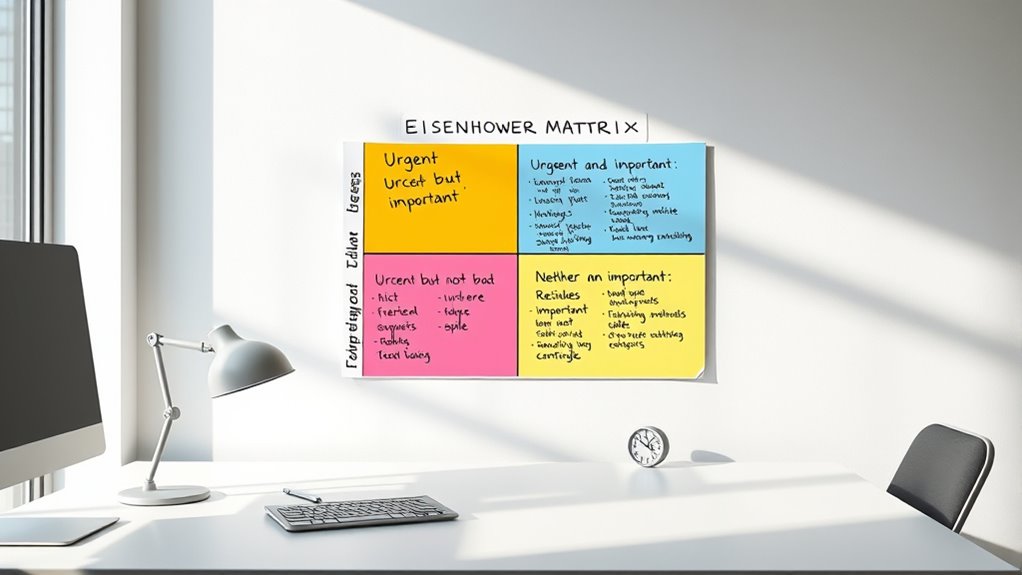
Implementing the Eisenhower Matrix into your daily routine begins with a simple but essential step: doing a brain dump. This helps you gather all tasks without judgment or filtering. Once you’ve listed everything, you can categorize them into the four quadrants. Here’s how to get started:
- Write down all tasks, big or small, urgent or not.
- Sort each task into the appropriate quadrant based on urgency and importance.
- Prioritize tasks within each quadrant, focusing first on Quadrant 1.
- Regularly review and update your list to reflect changing priorities. Understanding the priority levels helps you allocate your time more effectively and ensures that critical tasks receive the attention they deserve. Incorporating task management tools can further streamline this process and keep you organized. Recognizing task categories allows you to better distinguish between what truly requires your immediate focus and what can be delegated or deferred. This process ensures nothing gets overlooked and helps you manage your time effectively. Consistent practice makes prioritization automatic, reducing stress and boosting productivity.
Strategies for Prioritizing Quadrant 2 Tasks for Long-Term Success
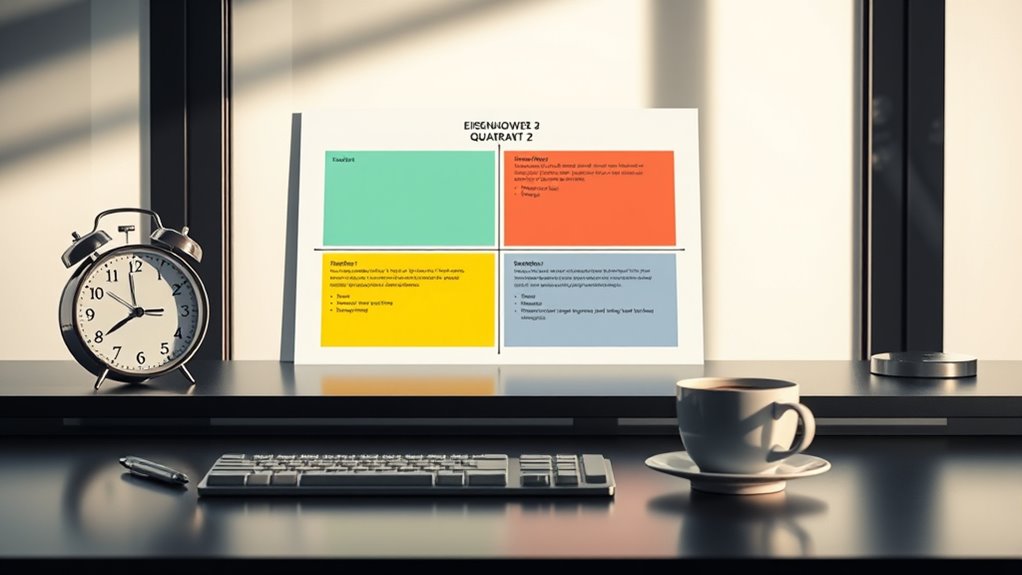
Prioritizing Quadrant 2 tasks is crucial for achieving long-term success, but it requires deliberate planning and consistent effort. These tasks, like personal development, strategic planning, and preventive activities, are essential for reducing future crises and building sustainable growth. To stay focused, schedule dedicated time blocks in your calendar and break tasks into manageable intervals using techniques like the Pomodoro method. Apply the 80/20 rule to concentrate on the most impactful activities. Set reminders and deadlines to prevent procrastination, and regularly review your goals to ensure alignment. Use digital tools for tracking progress and develop habits that prompt early action. By intentionally prioritizing these activities, you’ll foster proactive behavior, reduce stress, and create a solid foundation for long-term achievement.
Common Challenges and How to Overcome Them
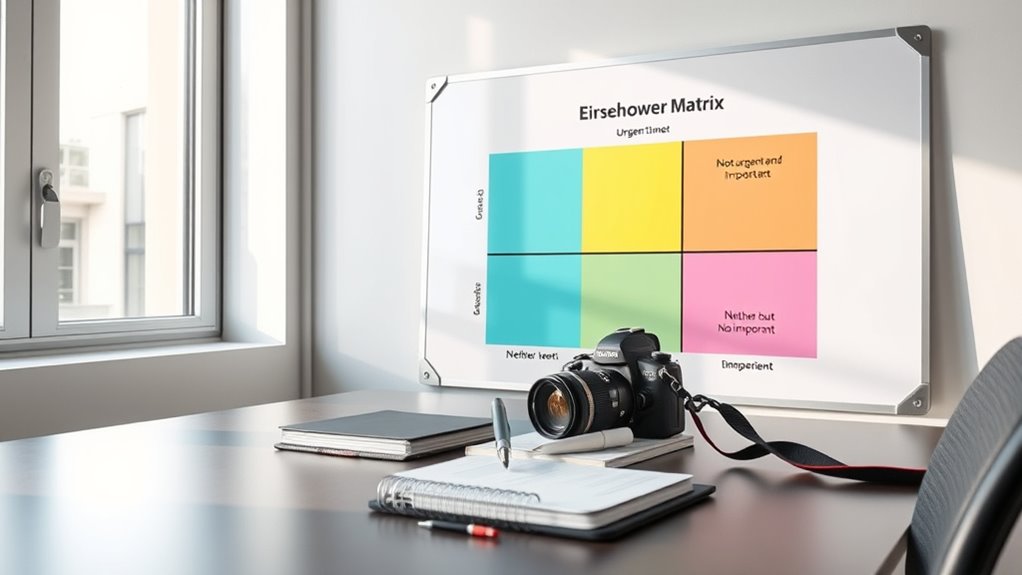
Many people struggle to accurately judge whether a task is urgent or important, leading to misclassification that hampers productivity. Focusing too much on urgent tasks often causes important but non-urgent work to be overlooked. To improve, establish clear criteria for distinguishing these tasks and regularly review your priorities.
Misjudging Task Urgency
Have you ever found yourself reacting to a task because it seemed urgent, only to realize later that it had little long-term impact? This misjudgment often happens when you confuse urgent tasks with important ones, leading you to focus on low-impact crises. To combat this, consider these strategies:
- Use clear criteria to distinguish urgent from important, focusing on consequences and deadlines.
- Apply the Eisenhower Matrix to visualize tasks and prioritize accordingly.
- Regularly reflect on your tasks’ impact and deadlines to avoid automatic urgency responses.
- Delegate or eliminate low-impact urgent tasks to free time for truly important work.
Overlooking Important Tasks
Overlooking important tasks often happens because urgent issues demand immediate attention, causing long-term priorities to fall by the wayside. You might focus too much on urgent matters, neglecting Quadrant 2 activities that guarantee future success. This challenge stems from prioritization bias, poor time management, or overload, making it easy to forget tasks that aren’t urgent yet essential. Using the Eisenhower Matrix helps you categorize tasks clearly, so you can prioritize long-term goals and prevent neglect. Regular reviews of your task list are indispensable to adjust priorities and avoid procrastination. Scheduling dedicated time for important but non-urgent tasks ensures they get addressed before becoming emergencies. By staying proactive and disciplined, you’ll better balance immediate demands with strategic priorities, reducing the risk of overlooking fundamental tasks.
Maximizing Productivity: Tips for Consistent Use of the Matrix
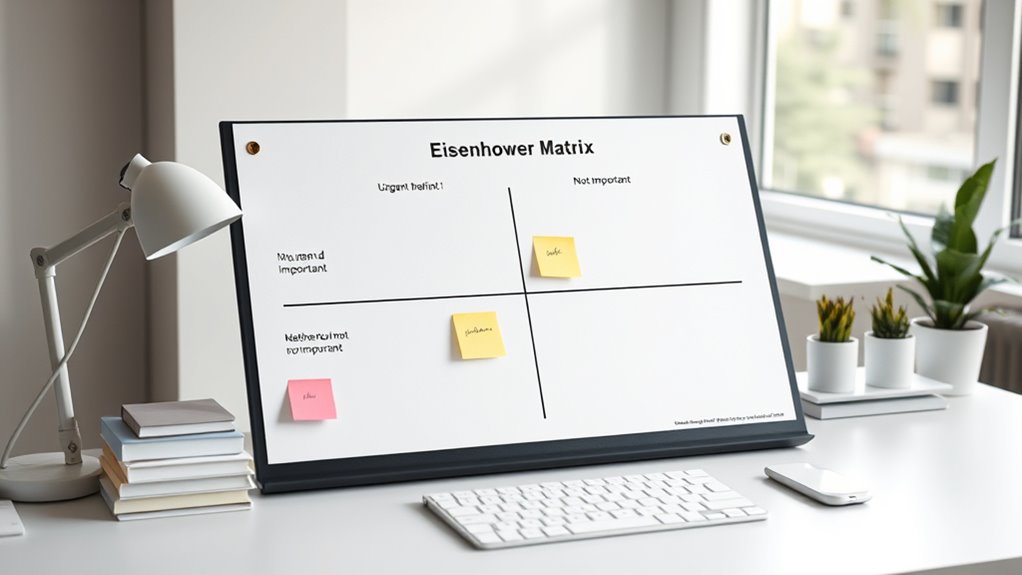
To maximize your productivity with the Eisenhower Matrix, consistency is key. Regularly review and adjust your priorities to stay aligned with your goals. Here are four tips to guarantee you’re using the matrix effectively:
- Color-code tasks to quickly identify urgency and importance, saving time on decision-making.
- Limit tasks per quadrant to prevent clutter and maintain focus on what truly matters.
- Schedule important but non-urgent tasks for later, ensuring steady progress without last-minute stress.
- Use productivity tools and techniques, like Pomodoro or automation, to stay on track and boost efficiency.
Frequently Asked Questions
How Can I Accurately Determine Task Importance Versus Urgency?
To accurately determine task importance versus urgency, first assess how each task aligns with your long-term goals and the impact it has on outcomes. Consider whether it requires immediate action or if it contributes to strategic priorities. Urgent tasks demand quick responses, while important ones focus on lasting value. By evaluating deadlines and long-term benefits, you can prioritize effectively and avoid wasting time on less critical activities.
What Tools or Apps Work Best for Implementing the Eisenhower Matrix?
Did you know 85% of people who use task management apps report increased productivity? For implementing the Eisenhower matrix, apps like Priority Matrix and Focus Matrix are top choices. They help you categorize tasks quickly, collaborate with your team, and visualize deadlines with Gantt charts. Web-based tools and printable templates also work well. Choose what fits your workflow to stay organized, focused, and reduce stress effectively.
How Often Should I Review and Update My Task Matrix?
You should review and update your task matrix regularly to stay organized and focused. Daily updates help you tackle urgent tasks promptly, while weekly comprehensive analyses keep your long-term goals on track. Schedule real-time adjustments for urgent matters and quarterly recalibrations to align with evolving priorities. Avoid stagnation by revisiting your matrix often, especially after milestones, ensuring your tasks reflect current needs and prevent unnecessary stress or overlooked deadlines.
Can the Matrix Adapt to Changing Priorities Over Time?
Imagine steering a boat through changing tides—your priorities shift, so your map must too. The matrix adapts easily over time, letting you reclassify tasks as circumstances evolve. Regular reviews and digital tools like Trello help you stay flexible, ensuring urgent tasks don’t overshadow long-term goals. With this approach, your priorities stay aligned with reality, allowing you to navigate smoothly through ever-changing waters.
How Do I Handle Tasks That Fall Into Multiple Quadrants?
When you face tasks that fall into multiple quadrants, focus on their most critical elements to decide how to handle them. Break these tasks into smaller steps, prioritize the urgent and important parts first, and delegate or schedule the less urgent or important aspects. Clear communication and regular review help you stay aligned with your goals, ensuring you manage complex tasks efficiently without losing sight of their overall impact.
Conclusion
By mastering the Eisenhower Matrix, you can take control of your priorities and make meaningful progress. Will you let urgent chaos dictate your day, or will you choose to focus on what truly matters? Remember, consistent use transforms tasks into accomplishments. Embrace this powerful tool, and watch your productivity soar. Are you ready to prioritize like a president and lead your day with purpose? The choice is yours—make it count.


